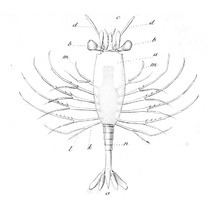Scientific name Amphionides reynaudii Higher classification Amphionides | Subphylum Crustacea Rank Species | |
 | ||
Order AmphionidaceaD. I. Williamson, 1973 Family AmphionididaeHolthuis, 1955 Genus AmphionidesZimmer, 1904 Similar Mictacea, Thermosbaenacea, Anaspidacea, Bathynellacea, Leptostraca | ||
Amphionides reynaudii is the sole representative of the order Amphionidacea, and is a small (less than one inch long) planktonic crustacean found throughout the world's tropical oceans, the larvae mostly in shallow waters, and the adults at greater depth.
Contents
Description
Amphionides grows to a length of 25 millimetres (1 in). Morphologically, Amphionides is somewhat unusual, with many body parts being reduced or absent. For example, it has only one pair of mouthparts – the maxillae – the mandibles and maxillules being vestigial.
Males and females differ in the form of the antennae, and also by the presence in males of the eighth thoracic appendage, albeit in a reduced form. This is the site of the male gonopore (the female's gonopore is on the sixth thoracic appendage). The first pleopod of the female is greatly enlarged and almost encloses the enlarged carapace. This is assumed to be a chamber in which the eggs are fertilised and retained until hatching. The more streamlined carapace and pleopods of the male make it more hydrodynamic, and so fewer males are caught than females.
Distribution and ecology
Amphionides reynaudii has a cosmopolitan distribution in the world's tropical oceans. It is planktonic, inhabiting waters less than 100 metres (330 ft) deep as a larva, but more often at depths of 700–1,700 m (2,300–5,600 ft) as an adult.
Classification
Originally described from its larvae, Amphionides was originally thought to be a shrimp. It was not until 1969 that the adult form was observed to be that described by Carl Wilhelm Erich Zimmer in 1904, and only in 1973 was Amphionides placed in its own order by Donald I. Williamson. The specific epithet reynaudii was given by Henri Milne-Edwards in honour of a friend of his, possibly Count François Dominique Reynaud de Montlosier. The generic name used by Milne-Edwards, Amphion, was invalid as a junior homonym of Amphion Hübner, 1819, a genus of hawk moths.
